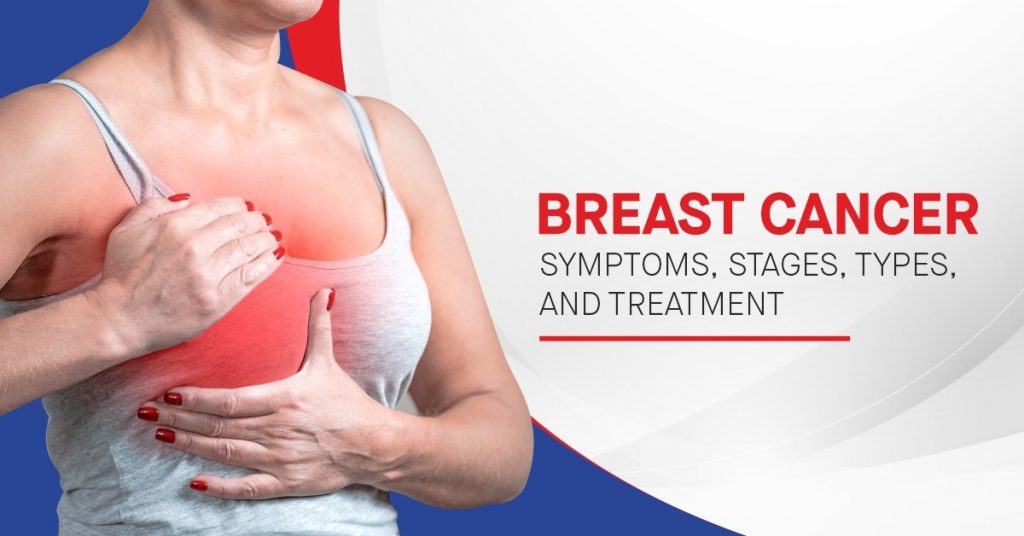As you age and gain weight, your chances of developing breast cancer increase. Breast cancer is caused when cells in your breast grow and divide uncontrollably, creating a mass of tissue called a tumor.
Women who have breast cancer may feel a lump in their breast, experience changes to their breast size, or notice changes to the skin on their breasts. Mammograms are an aid for early detection.
What is Breast Cancer?
Different kinds of breast cancer occur depending on which cells grow uncontrollably in the breast. The type of cancer that develops depends on the type of faulty cells in the breast.
Several types of breast cancer can occur in various parts of the breast. It mainly consists of three main parts: lobules, ducts, and connective tissues. Lobules are the glands that make milk. Milk is transported to the nipple by ducts.
Breast cancer usually begins in the lobules or ducts of the connective tissue, which is composed of fibrous and fatty tissue. Blood vessels and lymph vessels can enable breast cancer to spread outside the breast. If breast cancer spreads outside the breast, it is said to have metastasized.
Signs and Symptoms of Breast Cancer:
Signs and symptoms of breast cancer include:
- There is a lump or swelling in your breast, upper chest, or armpit
- Puffiness or dimpling of the skin
- Breasts may become inflamed or red as a result of a change in color
- An inverted nipple, for example, has been pulled in
- Crust or rash around the nipple
- Discharge of liquid (discharge) from either nipple
- Changes in the size or shape of the breasts can be seen in breast cancer
Types of breast cancer:
Your doctor will carefully evaluate the specifics of the breast tumor to determine which kind of treatment is appropriate. This includes evaluating the tumor’s size, shape, location, and severity.
As with many other cancer types, breast adenocarcinomas usually occur in milk-producing glands or milk ducts. Breast adenocarcinomas are located in such glands as lobules or milk ducts.
Invasive breast cancer (NST):
NST stands for No Special Type, which indicates the cancer cells have spread into the surrounding breast tissue. Those who have invasive breast cancer have cancer cells spreading into the surrounding breast tissue.
A large number of invasive breast cancers do not have special features, so they are classified as No Special Type. NST is also known as NOS (no other specific type). Formerly, it was referred to as invasive ductal carcinoma. Around 70 out of 100 (around 70 percent) invasive breast cancers fall into this category.
Cancer is classified as a special type and has particular characteristics when viewed under a microscope by the doctor. Breast cancers that are classified as special types are some rare cancers.
Invasive lobular breast cancer:
Cancer that has spread from the cells lining the lobules of the breast into the surrounding tissue is called invasive lobular breast cancer. The lobules make milk during breastfeeding.
Among the most common types of breast cancer, invasive lobular cancer is the second most common. Around 15 of every 100 breast cancers (around 15%) are invasive lobular cancer. This cancer can develop at any age, but it is more prevalent among women between 45 and 55 years of age.
Breast cancer is rare in men. It is extremely uncommon for men to develop an invasive lobular form of breast cancer.
Triple-negative breast cancer:
In triple-negative breast cancer, the cells do not have receptors for:
- The hormones estrogen and progesterone
- Her2 protein
You might have this testing following a biopsy or surgery to remove your cancer. Your doctor may test cells for these receptors using a sample of your cancer.
There is a rare type of breast cancer known as basal type breast cancer that usually has a triple-negative status. The BRCA1 gene defect can increase breast cancer risk in some women with triple-negative breast cancer.
It is very rare for men to have triple-negative breast cancer because most men’s cancer cells contain estrogen receptors.
Inflammatory breast cancer:
Breast cancer blocks the smallest lymph channels. The lymphatic system consists of these channels. These channels are responsible for draining excess fluid from the body’s tissues and organs.
By blocking lymph channels, the lymph cannot perform its function properly. This blockage causes red, inflamed skin. About 1 in 100 breast cancers (1 in 5) are inflammatory breast cancers.
This is due to the similarities between the symptoms of inflammatory breast cancer and mastitis, which is uncommon among women who aren’t pregnant or breastfeeding, and particularly rare in women who have gone through menopause.
Rare Types of Breast Cancer:
Find out about some of the other uncommon forms of breast cancer and how they are treated.
- Grouping breast cancers: Doctors have categorized breast cancer into different types. Rarer cancers are sometimes called special types, and more common cancers are called no special types.
The majority of breast cancers are invasive carcinomas – no particular type. Around 70 out of 100 (around 70%) breast cancers are of this type. This is also known as an NST or NOS (not otherwise specified).
When the doctor examines the cells under a microscope, he can see that special types of breast cancers have cells with special features.
Angiosarcoma of the breast:
It is uncommon and makes up less than 1 percent (less than 1%) of all breast cancers. In angiosarcomas, cells that line blood vessels or lymphatic vessels develop into cancer.
These types of breast cancer typically affect women, though men can also get them. They include:
- primary angiosarcoma
- secondary angiosarcoma
Angiosarcomas of the breast typically begin in the breast tissue and can spread to the breast skin and are more common in young women between the ages of 30 and 40.
Usually, women over 50 develop secondary angiosarcomas of the breast after undergoing radiation for previous breast cancer. These cancers usually occur after radiation therapy for previous breast cancer.
Read Also: Diet Tips to Maintain a Healthy Weight
Breast cancer in men:
About 350 men in the UK are diagnosed with breast cancer each year, compared to 55,000 cases of breast cancer in women. In the UK, 1 in 100 women suffers from breast cancer, and 1 in 10 men do.
In both women and men, invasive ductal carcinoma, no matter the type, is the most prevalent form of breast cancer. However, there are some differences as well between the two.
There are rare instances in which men develop breast cancer or conditions related to the disease. This includes inflammatory breast cancer, which is very rare.
- Ductal carcinoma in situ (DCIS)
- Invasive lobular cancer
- Paget’s disease of the breast
Ductal carcinoma in situ (DCIS): A DCIS is characterized by the appearance of cancerous cells lining the ducts of the breast tissue. These cells are all contained within the ducts, and they have not started to spread beyond that.
Lobular carcinoma in situ (LCIS): It is not cancer but rather a condition where cells within certain breast lobules have begun to become abnormal. In the lobules, where breast milk is produced, abnormal cells are contained within the inner lining. It is also known as lobular neoplasia. It may affect both breasts.
Paget’s disease of the breast: Paget’s disease develops in the nipple of the breast or the darker region surrounding it (the areola). It is a sign that there is breast cancer behind the nipple. There is a possibility that someone could have Paget’s disease without having breast cancer, but it is very uncommon.
Breast cancer stages:
A higher cancer stage number indicates a more advanced disease. However, there are other factors to consider. Stage numbers begin with zero and go up through I, II, III, or IV (often preceded by A, B, or C).
Stage 0: In this case, the cancer was found early on. It began in the milk glands or milk ducts and has remained there. You may hear or see the words in situ, which means “in the original place.”
Stage I: Breast cancer is considered invasive when it invades healthy tissue at this level.
Stage 1A is characterized by cancer spreading to the fatty tissues of the breast. The tumor itself is small and may not even exist.
Stage 1B means cancer cells have been detected in some lymph nodes, though in extremely small amounts.
Stage II: Cancer has grown, spread, or both.
Stage IIA indicates the breast tumor is still small if there is even one. There may or may not be cancer in the lymph nodes, which may have spread to three.
Stage IIB breast cancer is bigger, it can be as big as a walnut or lime. There may or may not be any lymph nodes involved.
Stage III: There has been no spread of cancer to bones or organs, but it is advanced, and it is more difficult to battle.
Stage IV: In this stage, cancer has spread far beyond the area where it first appeared. The bones, the lungs, the liver, and the brain are the most commonly infected sites. This stage is known as “metastatic,” which means it has spread beyond the area of the body it was originally found in.
Male Breast Cancer:
Women tend to get breast cancer, but men can also develop it. Many people are unaware that men have breast tissue and that they can get breast cancer. Any part of the body can develop cancer and spread to other parts.
In breast cancer, cells grow uncontrollably and form a tumor. These cells form a tumor that can usually be seen on an x-ray or felt as a lump. The tumor is malignant (cancer) if the cells invade the surrounding tissues or spread (metastasize) to distant parts of the body.
Diagnosis of Breast cancer:
Breast cancer is often found or diagnosed using additional tests. Women are often referred to a breast specialist or a surgeon for further evaluation. This does not mean they have cancer or that they need surgery.
- Breast ultrasound: Sound waves are used to take pictures of inside breast tissue, called sonograms.
- Diagnostic mammogram: In some cases, your doctor may recommend a diagnostic mammogram if you have a problem with your breasts, such as lumps or abnormalities on a screening mammogram. A diagnostic mammogram shows more information about what’s going on in your breast.
- Breast magnetic resonance imaging (MRI): The MRI scan produces detailed pictures of an area within the breast using a magnet and computer.
- Biopsy: There are different kinds of biopsies (e.g., fine-needle aspiration, core biopsy, or open biopsy). Biopsies remove tissue or fluid from the breast so that it can be examined under a microscope and monitored further.
Risk factors for Breast Cancer:
- Age: As with many other diseases, the risk of developing breast cancer increases as you get older; approximately two out of every three women over 55 will develop invasive breast cancer.
- Family History: Breast cancer rates are higher among women with close relatives who have been diagnosed. If one of your first-degree female relatives (a sister, mother, daughter) was diagnosed with the disease, your chances of developing the disease double.
- Genetics: Breast cancer is thought to be hereditary in 5% to 10% of cases, caused by abnormal genes that are passed from parent to child.
- Personal History of Breast Cancer: Having breast cancer increases your risk of developing new cancer in the other breast or another part of the same breast three to four times. This risk is different from the risk of recurrence of original cancer.
- Race/Ethnicity: There is a slight increase in cancer rates for White, Asian, and Hispanic women. Black women have a higher rate of more aggressive, earlier-stage cancer diagnosed at a young age.
Breast cancer prevention:
Research continues to explore the impact of specific foods and diets on breast cancer prevention, but the connection between diet and the disease remains unclear. Here are some prevention tips for breast cancer are:
Plant foods: Diets low in refined carbohydrates and animal products and high in vegetables, fruits, and whole grains are associated with lower postmenopausal breast cancer risks, according to moderate evidence.
Mediterranean Diet: Researchers have shown that a Mediterranean-style diet reduces breast cancer mortality. There is also evidence that it reduces obesity, which may increase the risk of developing breast cancer.
Calcium-rich diets: Several studies have found that a high-calcium diet may protect against breast cancer. Dairy products contain significant amounts of calcium, vitamin D, and linoleic acids, all of which may contribute to breast cancer prevention.
Foods to avoid: There is no specific association between certain foods and breast cancer. However, several factors, including poor diet, may contribute to cancer risk. The American Cancer Society recommends that you limit or eliminate these foods from your diet to achieve a healthy eating pattern.
- red meats and processed meats
- sugar-sweetened beverages
- refined grain products
- highly processed foods
- alcohol
Breast Cancer Awareness:
Increasing awareness, better opportunities for early detection, and advances in treatment continue to improve the outlook for women with breast cancer.
October is Breast Cancer Awareness Month in the U.S., and the campaign aims to increase breast cancer awareness. Many organizations assist with early detection during Breast Cancer Awareness Month, and the campaign is designed to raise awareness.
Additionally, these groups organize breast cancer fundraisers, including walks and events that support breast cancer research and socioeconomically disadvantaged benefit patients.
Breast cancer treatment:
People with breast cancer usually receive several types of treatment depending on whether the cancer has spread or what kind it is. It is common for people with breast cancer to receive more than one kind of treatment.
- Surgery: Doctors remove cancerous tissue during an operation.
- Chemotherapy: Special medicines are given in your veins or taken as pills to shrink or kill the cancer cells.
- Hormonal therapy: By blocking the hormones cancer cells need to grow, it prevents them from growing.
- Biological therapy: The treatment helps to fight cancer cells by utilizing your immune system or to control side effects from other cancer treatments.
- Radiation therapy kills cancer cells with high-energy rays (such as X-rays).


